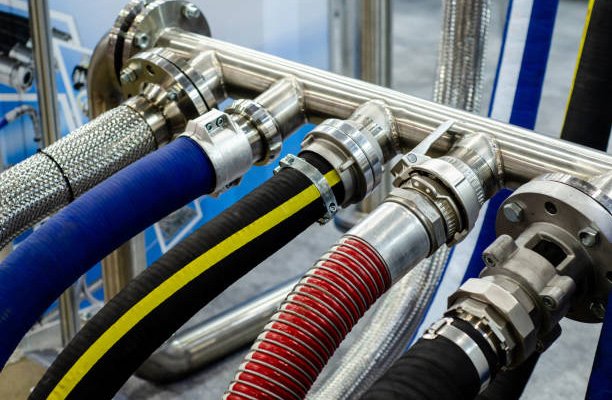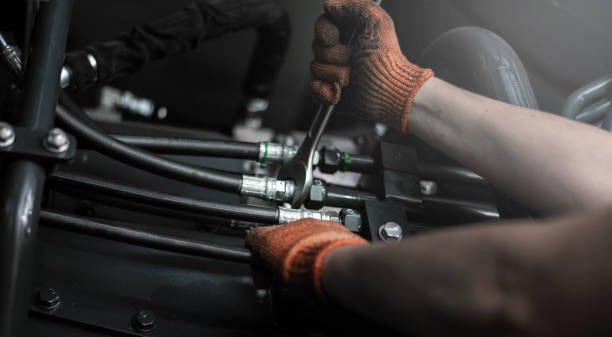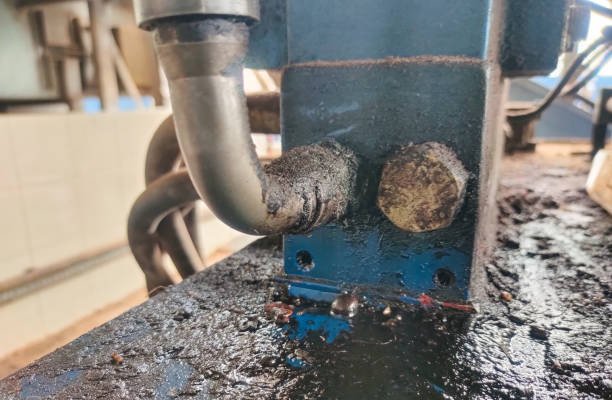Hydraulic hose fittings are a vital component in hydraulic systems, ensuring the proper transmission of fluid under pressure. However, loosening these fittings can sometimes be challenging due to wear, rust, and pressure buildup. This guide provides detailed instructions on how to loosen hydraulic hose fittings safely and efficiently, ensuring minimal damage to your system and avoiding costly repairs or accidents.
Hydraulic systems are commonly used in a wide range of industries, from manufacturing to construction. These systems rely on strong, pressurized hoses and fittings to operate effectively. But over time, hydraulic hose fittings may become stuck or challenging to remove. Whether you’re performing routine maintenance or replacing damaged components, learning how to loosen hydraulic hose fittings properly can prevent leaks, reduce downtime, and improve system efficiency.
Safety First: Key Considerations Before Loosening a Hydraulic Hose Fitting
Before starting any maintenance work, it’s critical to prioritize safety. Hydraulic systems operate under extreme pressure, and loosening a fitting without proper precautions can result in severe injuries. Here are some essential safety measures:
- Depressurize the system to avoid sudden fluid bursts.
- Wear protective gear including goggles and gloves.
- Work in a well-ventilated area, especially if using penetrating oil or sealants.
Tools Needed to Loosen Hydraulic Hose Fittings
Ensure you have the right tools at hand:
- Hydraulic wrench (specific to fitting sizes)
- Penetrating oil to break up rust and corrosion
- Torque wrench to ensure proper reassembly
Step-by-Step Guide on How to Loosen Hydraulic Hose Fitting
Now that you have the tools ready, here’s how you can safely loosen a hydraulic hose fitting step by step:
Inspect the Area
Before beginning, visually inspect the hydraulic system and the hose fitting. Check for signs of damage, rust, or excessive wear. If you notice any significant issues, replacement might be necessary rather than simply loosening the fitting.
Depressurize the Hydraulic System
This is the most critical step. Hydraulic systems can operate at extremely high pressures, and attempting to loosen a hose fitting without relieving the pressure can cause serious accidents. Consult the machine’s manual for instructions on how to properly depressurize the system.
- Turn off the machine or system.
- Release any residual pressure through the appropriate valves or mechanisms.
- Ensure that the system is completely depressurized before continuing.
Apply Penetrating Oil
If the fitting seems stuck, applying penetrating oil can help loosen rust or grime that may have built up over time. Spray the oil around the threads of the fitting and allow it to sit for a few minutes. This step helps ease the process, especially in older hydraulic systems where fittings may have corroded.
Choose the Right Wrench
Using the correct wrench is essential to avoid stripping the fitting. If the fitting is rusted or particularly stubborn, use a hydraulic-specific wrench that fits snugly over the fitting. Adjustable wrenches can work in many cases, but they must fit tightly to avoid slipping.
- Ensure the wrench is the correct size for the fitting.
- If you’re unsure of the size, refer to the manufacturer’s guide or the equipment manual.
Loosen the Fitting
Once the system is depressurized and the wrench is in place, apply steady pressure to loosen the fitting. It’s important to go slow—don’t jerk or yank at the fitting, as this can cause damage to the threads or the fitting itself.
- Turn the wrench counterclockwise to loosen the fitting.
- If the fitting doesn’t loosen easily, apply a bit more penetrating oil and give it another try after a few minutes.
Inspect for Leaks or Damage
After the fitting has been successfully loosened, take the time to inspect the surrounding area for any signs of leaks or damage. If you notice any, the hose or fitting may need to be replaced.
Reassembly and Reinstallation
Once you’ve completed the necessary repairs or replacements, it’s time to reinstall the fitting. Before tightening the fitting back into place, apply thread sealant or Teflon tape to ensure a leak-free seal.
- Use a torque wrench to tighten the fitting to the manufacturer’s recommended torque settings.
- After reassembly, run the hydraulic system and inspect for leaks or signs of loose fittings.
Common Mistakes to Avoid When Loosening Hydraulic Hose Fittings
Loosening hydraulic hose fittings may seem straightforward, but there are common mistakes that can cause damage or safety risks. Here’s what to avoid:
- Forgetting to Depressurize the System: This is the most dangerous mistake. Always ensure the system is fully depressurized before starting.
- Using the Wrong Tools: Using the wrong wrench can damage the fitting or strip the threads, making it difficult to reassemble or causing leaks.
- Over-tightening After Reassembly: Hydraulic fittings must be tightened to specific torque settings. Over-tightening can damage the fitting or cause leaks under high pressure.
Why Proper Maintenance of Hydraulic Hose Fittings Is Crucial
Hydraulic systems are essential to the smooth operation of many industries. Regular maintenance, including loosening and inspecting fittings, ensures the longevity and safety of the system. Properly maintained fittings prevent leaks, improve efficiency, and reduce the risk of catastrophic failure due to pressure loss or fluid escape.
Types of Hydraulic Hose Fittings and How They Impact Loosening
Hydraulic hose fittings come in various types, and understanding their specific design can help you select the right tools and techniques for loosening them. Some common types of fittings include:
- JIC (Joint Industry Council) Fittings: These are widely used for their 37-degree flare seating surface, making them easier to loosen and providing a strong seal under high pressure.
- O-ring Face Seal Fittings: Designed for high-vibration applications, these fittings feature an O-ring inside the thread, which can make loosening trickier due to sealing over time.
- BSP (British Standard Pipe) Fittings: Common in Europe, BSP fittings can be prone to corrosion, especially in outdoor environments, requiring additional care when loosening.
- Flat Face Fittings: Known for preventing leaks, these fittings often require a hydraulic-specific wrench for loosening.
Different fitting types may require slightly different techniques for loosening, especially under high pressure or in extreme environments. Always check the fitting type before starting work.
How to Identify and Troubleshoot a Stubborn Hydraulic Hose Fitting
If your hydraulic hose fitting won’t budge, don’t panic. Troubleshooting a stubborn fitting can save time and prevent damage. Here’s what to do:
- Check for corrosion: Corrosion or rust might be the issue. Applying penetrating oil and letting it sit for a few minutes should help break it down.
- Apply heat: In some cases, gently applying heat to the fitting can expand the metal, making it easier to loosen. Be cautious and use appropriate heat sources.
- Use a breaker bar: If the fitting remains stuck, a breaker bar can provide the extra leverage you need to get it loose.
- Tap with a hammer: Tapping the fitting gently with a hammer while applying torque can sometimes dislodge stuck threads.
If none of these methods work, consider professional hydraulic service assistance to avoid damaging your system.

Best Practices for Reassembling Hydraulic Hose Fittings
Once you’ve successfully loosened the fitting and performed any necessary repairs, proper reassembly is crucial to avoid leaks or future fitting issues. Here are best practices for reassembling hydraulic hose fittings:
- Apply thread sealant or Teflon tape to ensure a proper seal when reassembling.
- Use a torque wrench to tighten the fitting to the manufacturer’s specifications. Over-tightening can strip threads, while under-tightening can lead to leaks.
- Inspect the fitting for proper alignment to ensure the hose and fitting seat correctly.
- Test the system after reassembly by running it under low pressure initially, checking for leaks around the fitting.
By following these steps, you can extend the life of your hydraulic system and prevent future issues.
How Environmental Conditions Affect Hydraulic Hose Fittings
Environmental factors can have a significant impact on hydraulic hose fittings, particularly in industries where machines are exposed to extreme weather or harsh working conditions. Here’s how various environmental conditions can affect your fittings and the steps you can take to prevent damage:
- Corrosion from moisture or chemicals: If your hydraulic system operates in damp environments or around corrosive chemicals, fittings can rust or degrade quickly. To prevent this, use stainless steel or coated fittings that offer better resistance to corrosion.
- Temperature extremes: Both very high and very low temperatures can cause fittings to expand, contract, or even crack, making them more difficult to loosen. Use temperature-resistant fittings and regularly inspect them for signs of wear or fatigue.
- Vibration and shock: Constant vibration can loosen fittings over time. For systems exposed to frequent vibration, consider using O-ring face seal fittings, which are designed to handle these conditions better.
Understanding how environmental conditions affect your hydraulic system will allow you to perform maintenance proactively and avoid future fitting issues.
The Importance of Proper Torque in Hydraulic Fittings
One of the most overlooked aspects of hydraulic fitting maintenance is the role of proper torque in both loosening and tightening fittings. Applying the right amount of torque when reassembling hydraulic fittings is critical to preventing leaks and ensuring a secure seal. Here’s why torque matters:
- Over-tightening: Applying too much torque can damage the fitting threads or deform the hydraulic hose, leading to leaks or component failure under high pressure.
- Under-tightening: If the fitting is not tightened enough, it can lead to fluid leakage, reducing system efficiency and potentially causing safety hazards.
- Correct torque: Using a torque wrench ensures that fittings are tightened to the manufacturer’s specifications, creating a reliable, leak-proof seal.
To achieve the correct torque, always refer to the equipment manual or manufacturer’s guidelines. Never tighten fittings by hand, as this increases the risk of improper assembly.
Hydraulic Fluid Considerations When Loosening Fittings
The type of hydraulic fluid in your system can affect the process of loosening fittings. Different fluids have unique properties that influence how they interact with fittings and hoses over time:
- Water-based fluids: More prone to causing rust and corrosion around fittings, especially if the system isn’t properly maintained. You may need to apply more penetrating oil in these cases.
- Synthetic oils: Some synthetic oils can cause seals or hoses to wear down faster, leading to fitting leakage. Ensure that you use the correct sealant during reassembly.
- Mineral-based fluids: These tend to be less corrosive but may still lead to wear and tear over time, particularly in high-temperature environments.
When working with hydraulic systems, always ensure that you are using the correct type of fluid recommended by the manufacturer. If in doubt, consult the equipment manual or a hydraulic expert.
How to Choose the Right Replacement Hydraulic Hose and Fitting

If you’ve loosened the hydraulic fitting to replace a damaged hose, it’s essential to select the right replacement components. Here’s what to consider when choosing a new hose and fitting:
- Pressure rating: Ensure that the hose and fitting are rated for the maximum operating pressure of your hydraulic system.
- Compatibility with fluid type: Check that the hose and fitting materials are compatible with the type of hydraulic fluid in your system.
- Environmental resistance: If your equipment operates in harsh environments, opt for hoses and fittings that are resistant to temperature extremes, UV exposure, or corrosive chemicals.
- Fitting size and type: Make sure that the replacement fitting is the correct size and matches the type used in your system (e.g., JIC, BSP, etc.).
Selecting the right replacement parts will ensure that your hydraulic system functions effectively and reduces the risk of future fitting issues.
Preventive Maintenance Tips for Hydraulic Hose Fittings
Preventive maintenance is key to keeping your hydraulic system running smoothly and avoiding issues with stuck or damaged fittings. Here are some tips to maintain your fittings and ensure longevity:
- Regular inspections: Check your hydraulic fittings periodically for signs of wear, rust, or leaks. Catching problems early can prevent more significant issues down the line.
- Use protective caps: If your machine is not in use, covering exposed fittings with protective caps can prevent dirt, moisture, and debris from entering and causing corrosion or damage.
- Apply anti-seize compounds: For fittings that are frequently removed and reassembled, using an anti-seize compound can help prevent them from becoming stuck over time.
- Monitor system pressure: Excessive pressure can wear out fittings faster. Ensure that your hydraulic system is operating within the correct pressure range.
Following these preventive maintenance tips will help you avoid future issues with stuck fittings and extend the life of your hydraulic system.
Hydraulic Hose Fitting Safety Regulations and Standards
Adhering to safety standards and regulations is critical when working with hydraulic systems. In most industries, there are specific guidelines regarding the installation, maintenance, and repair of hydraulic systems, including the fittings. Here are some commonly referenced safety standards:
- ISO (International Organization for Standardization): Many hydraulic fittings must adhere to ISO standards to ensure safety and performance. These standards provide guidelines for fitting types, pressure ratings, and thread dimensions.
- OSHA (Occupational Safety and Health Administration): OSHA regulations require safe handling of hydraulic systems in industrial environments, including proper maintenance and fitting inspection protocols to avoid workplace accidents.
- SAE (Society of Automotive Engineers): SAE standards cover the design, assembly, and performance testing of hydraulic fittings, ensuring that systems operate safely under high pressure.
Ensuring that your hydraulic system complies with these standards not only protects workers but also ensures the system operates efficiently and safely.
Conclusion
Loosening hydraulic hose fittings can be a straightforward task if you follow the correct procedures and use the right tools. However, it’s critical to prioritize safety, especially in high-pressure systems. By understanding the type of fitting, using proper torque, and following preventive maintenance practices, you can avoid costly repairs and extend the life of your hydraulic system. Whether you’re an industry professional or a DIY enthusiast, this guide provides all the essential steps and tips needed to handle hydraulic hose fittings effectively.
FAQs
How do I know if my hydraulic hose fitting is too tight?
If you cannot loosen the fitting even with proper tools and technique, it might be overtightened. The fitting should loosen with moderate effort using a suitable wrench. If you have to apply excessive force, it’s likely too tight or corroded.
What happens if I don’t depressurize the system before loosening the fitting?
Failing to depressurize the system can result in sudden fluid bursts, leading to personal injury or equipment damage. Always ensure the hydraulic system is fully depressurized before loosening any fittings.
Can I use regular oil instead of penetrating oil to loosen a stuck fitting?
While regular oil may offer some lubrication, penetrating oil is specifically designed to break down rust and corrosion, making it far more effective for loosening stuck fittings.
What should I do if my fitting is damaged after loosening?
If the fitting is damaged, it’s best to replace it rather than trying to reassemble it. Damaged fittings can lead to leaks and system inefficiency, and in high-pressure systems, they can be a safety hazard.
How often should I inspect hydraulic hose fittings?
Hydraulic hose fittings should be inspected regularly as part of a routine maintenance schedule, especially in systems operating under high pressure or in harsh environments. Monthly inspections are recommended in most industrial settings.
Can over-tightening a fitting cause leaks?
Yes, over-tightening a fitting can damage the threads or fitting itself, leading to leaks. Always use a torque wrench and follow the manufacturer’s recommended torque settings for reassembly.





